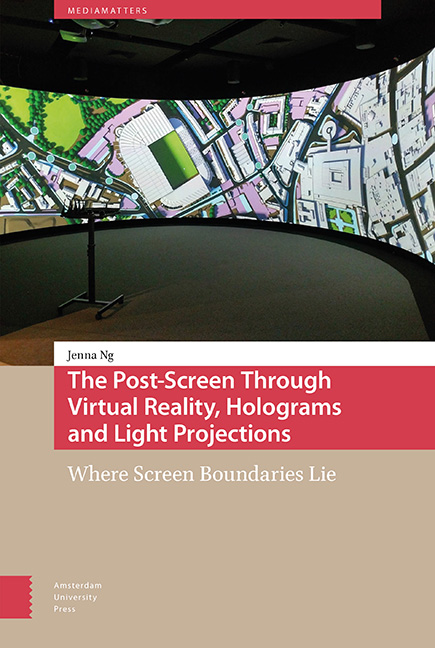 The Post-Screen through Virtual Reality, Holograms and Light Projections
The Post-Screen through Virtual Reality, Holograms and Light Projections Book contents
- Frontmatter
- Dedication
- Table of Contents
- Acknowledgements
- Introduction
- 1 Screen Boundaries as Movement
- 2 Leaking at the Edges
- 3 Virtual Reality: Confinement and Engulfment; Replacement and Re-placement
- 4 Holograms/Holographic Projections : Ghosts Amongst the Living; Ghosts of the Living
- 4A (Remix) True Holograms: A Different Kind of Screen; A Different Kind of Ghost
- 5 Light Projections: On the Matter of Light and the Lightness of Matter
- Conclusion/Coda
- Index
- Frontmatter
- Dedication
- Table of Contents
- Acknowledgements
- Introduction
- 1 Screen Boundaries as Movement
- 2 Leaking at the Edges
- 3 Virtual Reality: Confinement and Engulfment; Replacement and Re-placement
- 4 Holograms/Holographic Projections : Ghosts Amongst the Living; Ghosts of the Living
- 4A (Remix) True Holograms: A Different Kind of Screen; A Different Kind of Ghost
- 5 Light Projections: On the Matter of Light and the Lightness of Matter
- Conclusion/Coda
- Index
Summary
Abstract
This chapter continues thinking about the screen via its boundaries, where, despite strong associations of protection and partition, screens are also shown to be read as subject to rupture, breach and violation, whose violence, moreover, may be presented in gendered terms. Breaches of the screen also imbricate the virtual and the actual in (i) exposing the factual realness of the actual by the fictional realness of the virtual; and (ii) spillover, or “leakage,” of the virtual into the actual. With mobile and interactive media, screen boundaries diminish further as parties become virtually co-located and, as virtual worlds grow deeper and more complex, share them with algorithms. As demarcations between actual and virtual realities, screen boundaries grow increasingly unstable and fragile.
Keywords: protection; screen boundaries; found-footage; Covid-19; virtual co-location; algorithm
Protections and Partitions
Say something, goddammit! You’re on television!
∼ ChristofEverybody watches Truman Burbanks’ life onscreen. A character in Peter Weir's The Truman Show, Truman (played by Jim Carrey) is the unwitting star of a reality television programme. Unknown to Truman until near the film's end, the programme was created by svengali producer Christof (played by Ed Harris) to broadcast every aspect of Truman's life, supported by a cast of actors. Truman eventually cottons onto his fabricated life and escapes by literally sailing away from his “island” home, determined to leave behind his fake reality. The film's denouement lies in Truman's boat puncturing the wall of the dome which encloses the giant studio space in which he had lived his whole life, painted ironically to look like a cloud-dotted horizon. Truman gets off the boat and steps into the shallow water around it. He finds the door on the wall marked “Exit,” and opens it. In this climactic moment, Truman prepares to step across the boundary from a directed, created-for-television reality to ostensibly “true” reality.
In this moment, too, the wall becomes a double metaphor. It represents all the obstacles Truman had to overcome in order to escape – his ignorance of the circumstances of his life; his imagined aquaphobia; his uncertainty of what lay beyond the island he lived on – all of which he conquers by breaching the wall.
- Type
- Chapter
- Information
- The Post-Screen through Virtual Reality, Holograms and Light ProjectionsWhere Screen Boundaries Lie, pp. 79 - 106Publisher: Amsterdam University PressPrint publication year: 2021
